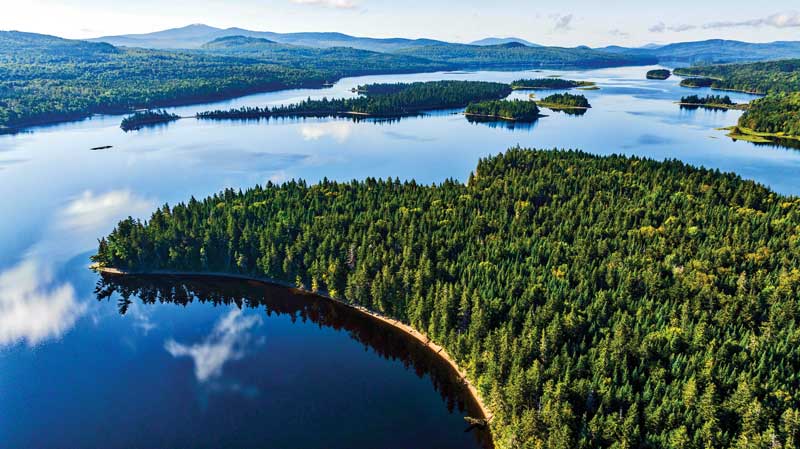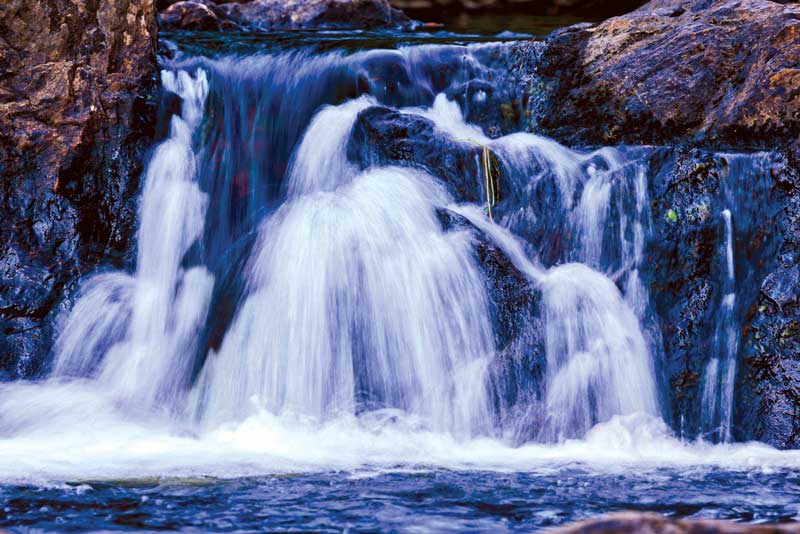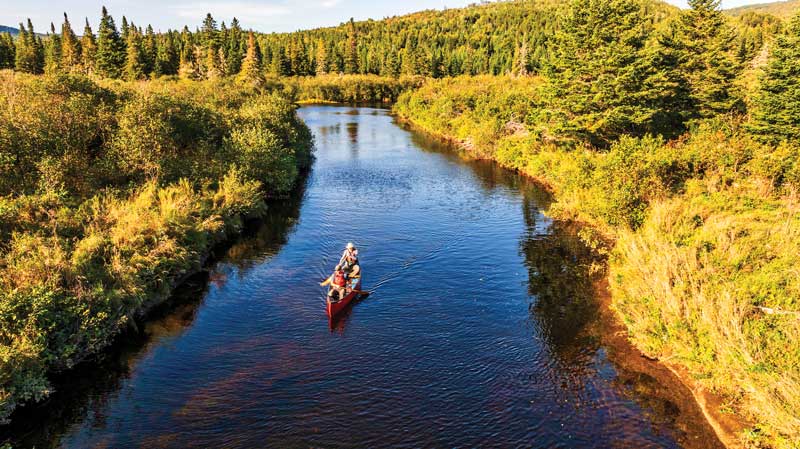Magalloway Conservation Project: Land Trusts Rally to Preserve Western Maine Landscape
Photos by Jerry Monkman/EcoPhotography
 Aziscohos Lake’s islands, waters, and shoreline lie in the heart of the Magalloway conservation project area and offer excellent recreational opportunities.
Aziscohos Lake’s islands, waters, and shoreline lie in the heart of the Magalloway conservation project area and offer excellent recreational opportunities.
World-class fishing, hunting, and camping. A sustainable timber harvest that supports local communities and Maine’s economy. Habitat for wildlife, clean air and water, and a critical carbon sink.
These are just a few of the many offerings in western Maine’s Magalloway region. An ambitious new conservation initiative is aimed at preserving a majestic, 78,000-acre swath of these peaks, valleys, and rivers for all the people and wildlife that depend on these lands.
The stakes are high. This region, like so many in Maine, is subject to potential private development that would restrict public access to the land. But now, through an innovative partnership of land conservation organizations known as the Magalloway Collaborative, there is a concerted effort to maintain these lands and waters as a shared resource for the people of Maine. The Collaborative has entered into a contract with Bayroot LLC, the current landowner, and has until May 2026 to raise the $62 million required to fund the purchase.
The Collaborative, which includes Rangeley Lakes Heritage Trust, Forest Society of Maine, Northeast Wilderness Trust, and The Nature Conservancy, is noteworthy for the diversity of interests it represents. Each organization has a unique conservation mission, and collectively the four groups will work together through this project to support forest product businesses, recreational uses, and wilderness.
 Little Boy Falls on the Magalloway River offers beauty and world class trout habitat.
Little Boy Falls on the Magalloway River offers beauty and world class trout habitat.
Maine’s lands—and how they are used and managed—often inspire debate, but uniting sometimes at-odds viewpoints is the shared recognition that the development of vast landscapes is a losing proposition for Mainers. The Magalloway Collaborative embraces that commonality. It represents the promise of land conservation: a shared philosophy of care for Maine’s lands and waters and a steadfast dedication to their preservation. And when one considers what it is that these groups have joined together to protect, the impetus for their partnership becomes crystal clear.
 This map shows proposed conservation outcomes of the Magalloway Project.
The outdoor recreation opportunities offered by Magalloway’s forests and waters are many—with superb hunting, fishing, camping, and other activities that connect us with the land and the state we call home. In a testament to the project’s significance for the region’s economy, the project has the endorsement of the Sportsman’s Alliance of Maine, Rangeley Region Guides’ and Sportsmen’s Association, as well as the Rangeley Lakes Snowmobile Club, the Rangeley Town Manager, and Maine’s Department of Inland Fisheries and Wildlife. As more and more of northern New England’s landscapes are cordoned off, the Magalloway lands and waters will remain a haven of access, while supporting the local economy.
This map shows proposed conservation outcomes of the Magalloway Project.
The outdoor recreation opportunities offered by Magalloway’s forests and waters are many—with superb hunting, fishing, camping, and other activities that connect us with the land and the state we call home. In a testament to the project’s significance for the region’s economy, the project has the endorsement of the Sportsman’s Alliance of Maine, Rangeley Region Guides’ and Sportsmen’s Association, as well as the Rangeley Lakes Snowmobile Club, the Rangeley Town Manager, and Maine’s Department of Inland Fisheries and Wildlife. As more and more of northern New England’s landscapes are cordoned off, the Magalloway lands and waters will remain a haven of access, while supporting the local economy.
The conserved lands of the Magalloway project will not only benefit the Mainers who use the land, but the remarkable wildlife that resides there. The Magalloway region teems with creatures both common and rare that all depend on intact interior forests to forage, breed, and raise their young. Iconic Maine species live here: moose, bobcat, even the elusive Canada lynx, a federally endangered and state species of special concern. The project’s conservation design—from 60,000-plus acres of sustainably managed timberlands to more than 10,000 acres of unmanaged wilderness—will create a vibrant tapestry of habitat for the region’s many species and their ecological needs.
 Wildlife abounds in the Magalloway region.
Wildlife abounds in the Magalloway region.
The protection of Magalloway’s 170 miles of rivers and streams, in particular, would be a major conservation triumph. These waterways have been identified as one of the last brook trout strongholds in the eastern United States under future climate-warming scenarios. The Magalloway conservation agreement stipulates the creation of 100-foot no-cut buffers along these high-priority streams and rivers, ensuring that the water remains cold and well oxygenated for these and other native fish.
The project will help safeguard this sparkling biodiversity even beyond the project’s borders. The land lies in the northern reaches of the Appalachians, connecting 500,000 acres of conservation lands in a critical ecological corridor that permits wildlife to move across the landscape. This mobility is all the more vital as temperatures rise with climate change: Many species are projected to adapt by shifting their ranges north.
 The Upper Magalloway River provides remote canoeing and fishing opportunities.
The Upper Magalloway River provides remote canoeing and fishing opportunities.
The potential positive impact of this historic project is greater than the sum of its parts. It offers an inclusive paradigm for conservation that unites people and groups with varying priorities in the pursuit of one dearly held goal: a collaborative, sustainable future for western Maine.
For those interested in learning more about the Magalloway project or in supporting the $62 million fundraising goal, visit magalloway.org.










